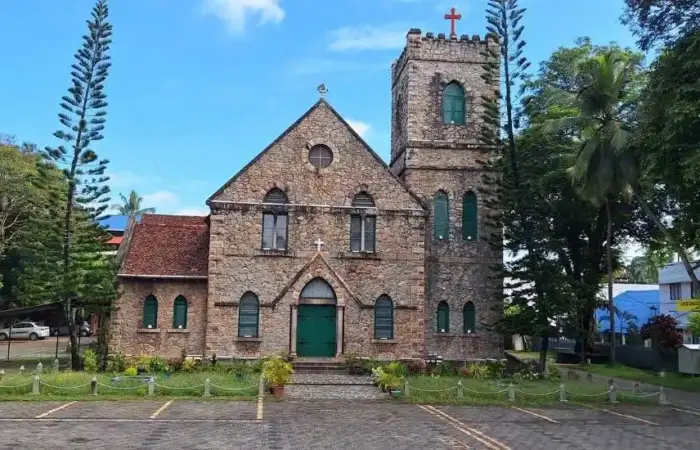
If South India is on your bucket list, think beyond a visit to its usual touristy places like beaches, backwaters, and hill stations for a change. Our recommendation is the incredible UNESCO World Heritage Sites in South India. It is here that you can experience the rich past of this incredible destination and the unprecedented feats of human engineering. All these sites charm every type of visitor and guarantee a soul-satisfying feast for all of your senses.
Here are the 7 exceptional UNESCO World Heritage Sites in South India worth adding to your South India itinerary.
Western Ghats:
The Western Ghats are an expansive natural treasure and the most beautiful region in South India. Known by many names, such as Western Ghats, Sahyadri, Sahyaparvata, Annamalai, Nilgiri, etc, these massive mountain ranges were awarded the status of World Heritage Site by UNESCO in 2012.
The Western Ghats are so prosperous with the presence of tea, coffee, and various spice plantations, and are home to a plethora of flora and fauna that are unique to the region, because of which it is recognised as one of the top 10 hottest hotspots of biological diversity in the whole world. It spreads over the Indian states of Maharashtra, Karnataka, Kerala, and Tamil Nadu.
Group of Monuments in Hampi:
The celestial site of Hampi in the Indian state of Karnataka boasts grandeur in its ruins. It is set on the banks of the Tungabhadra River in Karnataka’s Vijayanagara district. This erstwhile capital city of the powerful Vijayanagara Empire, today, is a UNESCO World Heritage Site that depicts the fine Dravidian style of art and architecture. There are magnificent palaces, marvellous temples, royal complexes, monumental gateways, intricately carved pillars, and more, which, though today are in ruins, leave a sense of awe, admiration, and delight in every onlooker.
The mind-blowing architecture and construction of the monuments in Hampi will leave you wondering how it was possible at a time with no modern technology, machinery, or tools. The most fascinating heritage monuments in Hampi are the mysterious Vijaya Vittala Temple with its Musical Pillars, the marvellous Virupaksha Temple, and the astounding Stone Chariot.
Group of Monuments in Mahabalipuram:
The architectural brilliance of the Group of Monuments in Mahabalipuram is so outstanding that it found itself a place in the esteemed list of UNESCO World Heritage Sites back in 1984. About 60 kilometres from Chennai, on the Coromandel Coast of the Bay of Bengal, lies this group of beautiful monuments that showcase the superior craftsmanship of the Pallava Dynasty.
Mahabalipuram is home to around 40 architectural marvels, believed to be built between the 7th and 8th centuries. Hewn from granite are amazing temples in the shape of chariots, adorned with sculptures of Hindu Gods and Goddesses, caves, rock reliefs, lion pilasters, and giant open-air reliefs – the most remarkable of these being the ‘Descent of the Ganges’, depicting the Descent of the sacred river Ganges to Earth from the heavens. Do not miss visiting the intricately carved Shore Temple.
Group of Monuments in Pattadakal:
The Group of Monuments in Pattadakal are a real treat for every history and religious buff. Pattadakal Group of Monuments comprises nine Hindu Temples and a Jain Sanctuary dating back to the seventh and eighth centuries. They stand as a testament to the architectural expertise of the Chalukya dynasty and were inscribed as a UNESCO World Heritage Site in 1987.
On the banks of the Malaprabha River in Karnataka lies the Pattadakal Group of Monuments. These monuments exhibit marvellous medieval architecture, blending design skills and styles from both North and South India. A must-visit is the Virupaksha Temple, built by Queen Lokamahadevi to commemorate her husband’s victory over the Southern kings. Kadashiddheswara, Jambu Lingeswarar, and Galaganatha are the other prominent temples you can find here.
Great Living Chola Temples:
If you haven’t yet made a visit to the Great Living Chola Temples, then you should add it to your travel bucket list. Thanjavur Brihadeeswara Temple, Brihadisvara Temple in Gangaikonda Cholapuram, and Darasuram Airavatesvara Temple, which make up the Great Living Chola Temples, are well worth a visit, leaving you speechless with their stunning architecture, intricate carvings, and bronze casting. All three temples are dedicated to Lord Shiva.
Constructed between the 11th and 12th centuries, the Great Living Chola Temples are a testimony to the craftsmanship of the Chola Empire, one of the most powerful and longest-ruling dynasties in Southern Indian history. It was given the status of a World Heritage Site by UNESCO in 1987.
Nilgiri Mountain Railway:
Nilgiri Mountain Railway, a 1,000 mm meter gauge railway built in 1908 by the British, is said to be the only meter gauge, rack railway in India. This classic British engineering marvel earned the title of UNESCO World Heritage Site in 2005.
This heritage Toy Train takes you on a joy ride through the spectacular sites of Ooty and Coonoor, chugging its way between the dense forests, dark, snaking tunnels, and passing by the verdant green slopes and gorgeous tea plantations. It is a 46 km long single-track railway and is said to be the steepest in Asia.
Kakatiya Rudreshwara (Ramappa) Temple:
Kakatiya Rudreshwara (Ramappa) Temple, located in the state of Telangana, is the latest addition to the list of UNESCO World Heritage Sites. A masterpiece of Kakatiyan-era architecture, this iconic temple is estimated to be at least 800 to 900 years old. Though the temple is dedicated to Lord Ramalingeswara, it is named after Ramappa, who was the main sculptor of the temple. Perhaps it is one of the very few temples in the world named after its sculptor. Kakatiya Rudreshwara Temple is especially known for its unique pyramidal structure made with porous, lightweight bricks and the musical pillars that produce musical notes when tapped.
Don’t miss a chance to explore these exquisite UNESCO World Heritage Sites in South India. Have you visited any of them?










